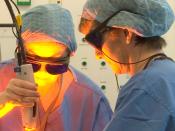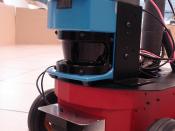Lasers can now improve health and personal appearance. They can erase wrinkles, scars, and smooth fine lines around people's faces. They can also remove discolorations on skin, broken blood vessels, and unwanted hair. Mild or moderate acne can also be treated by lasers. One of the most common uses is laser eye surgery. The lasers sculpt the surface of the cornea and this treatment allows people to see without glasses. Barron's magazine says that "Americans spend an estimated $13 billion a year on vision care" (Palmer 14). One drawback to laser eye surgery is that it may not work and leave vision wore than before. Laser surgery can also burn skin and trigger cold sores. The surgery is quite effective and someday, all surgery may be done by lasers.
The military has been trying for years to harness the power of lasers. In 1959, Hughes Aircraft Company first began work on laser weapons.
Between 1966 and 1968 the army had spent almost $9 million on laser research. Lasers: Humanity's Magic Light says "Scientists found that lasers did indeed produce very concentrated beams of light. But building the kinds of weapons the military wanted turned out to be much more difficult that everyone had figured" (Nardo 27). Handheld ray guns would require too much power and would get too hot. They would also be too expensive to make and at that price, ordinary rifles would be more effective. Then they started making big battlefield lasers to shoot down enemy planes and satellites. The advantage to lasers is that they need no fuel, can be bounced off mirrors instead of being moved, and they can shoot as far as up to 100 miles away. In 1973, the military shot down a drone with their battlefield laser. The drone was weaker and...



Opinion
i like the style of writing.
0 out of 0 people found this comment useful.